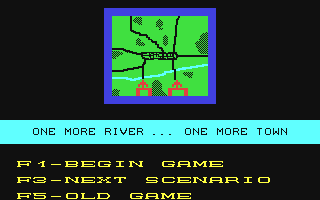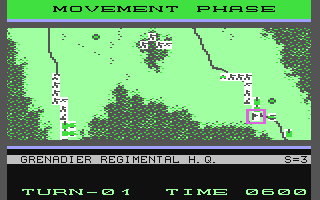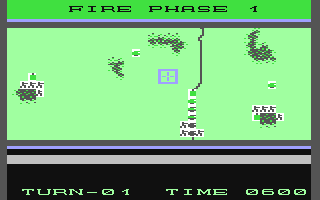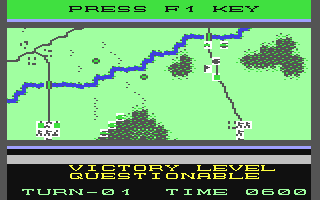|
The
Second World War was a time of innovation in the basics
of fighting; technology affected warfare in the First
World War, and it overtook it in the Second. The German
Army was particularly keen to develop and exploit the
technology of the battlefield. Tanks, which made their
appearance towards the end of the First World War, came
into their own in the Second. They were faster and tougher
than infantry and had infinitely more firepower, but
they could not do everything: only human beings had
the mobility to move into woods and towns to consolidate
the taking of territory, and so they had to work with
the armoured divisions. This raised the problem of the
different speeds of motorised units and slow-moving
infantry, a problem which was solved by the creation
of 'armoured infantry'. These divisions were the 'Panzer
Grenadiers' of the title.
This
game is essentially another shot at storming the Russian
front and doing a better job of it than the Germans
did. The player is given command of a grenadier regiment
of the Grossdeutschland Panzer Grenadier Division, along
with the elements of a panzer regiment and an artillery
battalion; all the forces, in fact, historically available
to the German commanders.

It
is a straightforward 'cardboard counters' style wargame,
and unlike some of SSI's range, is probably suitable
for the wargaming beginner. There are not huge tables
of necessary statistics to digest before starting or
tortuous orders sequences to become familiar with. To
some extent, this is a game you can pick up your joystick
and play. Experienced wargamers will have no trouble
'getting into' Panzer Grenadiers.
Once
the game has loaded from disk there is a choice of five
scenarios and three difficulty levels. The five scenarios
are all of similar length, and none last for more than
15 turns: there is no 'grand scenario', for each puts
the player into a completely different and high-focused
battle situation based on historical event. This is
a short-range wargame, and it's possible to play it
without getting much sense of the wider historical context.
The remedy to this, of course, is to study the comprehensive
(but digestable) notes and diagrams on each scenario
in the rulebook.

The
turns themselves are reasonably lengthy, so although
a 15-turn-long scenario sounds insubstantial -- and
it's true that there's no room for expansion -- it represents
quite a lot of playing time.
The
screen has a surprisingly arcade-like appearance, with
a smooth greyness to represent clear territory and unconvincing
hashes and blotches to indicate obstructions. This is
scrolled around by the joystick to the accompaniment
of an irritating clicking noise. There are actually
four types of terrain: clear, light, medium and heavy.
They incur movement costs and have a defensive value,
but -- and this is a common fault -- it is difficult
to make out on the screen which type of terrain is which.
Fortunately, each scenario is accompanied by a diagrammatic
map in the rulebook which goes some way towards making
up for the on-screen deficiency. But when the designer
has evidently decided to take some trouble, at least
over the aesthetics of the graphics, it seems a pity
that he did not make the screen easier to understand.

The
units, too, are pitifully small and indistinct. There
are 11 different types of units in the game, and the
distinction between them is very important to the gameplay.
Unfortunately, it is difficult to tell them apart on
screen. By positioning the joystick over each miniscule
unit, however, the player can summon up its name at
the bottom of the screen. Reference to the book makes
its function clear. The only statistic with which each
unit is equipped in the game itself is its strength,
which varies only from one to about four. The 'in game'
minimalism is compensated for by a complete description
of the capabilities of each particular type of unit,
which works very well in the context; after all, the
historical situation is taken as read and the only thing
that would vary in reality would be the strength of
the division as it was worn down in combat, unless one
takes into account abstractions like morale. The infantry
is divided into rifle companies, machine gun companies
and pioneers. There are six different motorized divisions,
including the immensely powerful Self-Propelled Artillery,
and a mortar section. The non-motorised divisions can
be transformed into such by loading them into trucks
and half-trucks, and so can keep up with the tanks.
The capabilities of each type of unit, detailed in the
rulebook, are firepower, range, defence and movement.
The most significant difference in play seems to be
range: the SPAs have an 'unlimited' range and so can
cause damage to the enemy without danger to themselves,
whereas the infantry units have to be within a square
of an enemy armoured target to cause any damage.
The
interaction of this wide range of unit types becomes
very satisfying in play, and would be more so if it
were easier to make out which was which on screen.

Turns
are organised in a substantial eight-phase structure.
The first is the 'observation' phase, which seems slightly
redundant; it gives the player the chance to scroll
around the battlefield (which he can do in any other
phase anyway) and take stock of the situation and also,
curiously, to order units to start digging in. Once
accustomed to the game, I found myself skipping the
observation phase routinely. The second phase is Fire
Phase 1, which gives the player the first chance at
combat. An attack either hits or doesn't hit, and the
player is informed of that; the unit has the same number
of attacks as its strength, in 'subunits'.
The
movement phase follows, and units are moved individually
by means, once again, of the joystick. Infantry units
can be loaded into trucks and transported with lightning
speed, but while in this state are very vulnerable to
attack. It's not possible to load, move and unload an
infantry unit in the same movement phase. After this,
the player has a chance to fire again, in exactly the
same way, from the new positions. Then it is the enemy's
turn.
The
player can choose to run the game at two speeds, last
and slow, which affects the speed at which the computer
carries out its movement and combat. At the slow speed
-- which isn't slow -- it's possible to follow what
the enemy is doing. The computer has the same fire-move-fire
phase structure as the player, and the only difference
to me seemed to be that the computer's attacks hit far
more often than mine!

The
next 'phase', the Victory Phase, is merely an assessment
of your performance so far. This is an interim report
on the state of the battle, which becomes final in the
last turn, and ranges from 'questionable' to 'major'.
The
rulebook is as excellently produced and presented as
SSI's usually are, and a description of the sequence
of play is set out in a way that is clear and easy to
follow. There is no general summary of the background
of the Russian campaign, but given that the game is
made up of five very short-range scenarios this is of
no great importance; the scenarios themselves are concisely
but adequately described, and are accompanied by detailed
hints on how to succeed in them. There are also designer's
notes which I always find entertaining reading even
if the author does use them to make excuses for any
obvious misdemeanours that he knows the reviewer is
going to pick out. The designer seems to be after my
own heart, using phrases like 'synergistic element'
. . .
|